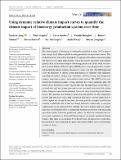| dc.contributor.author | de Jong, Sierk | |
| dc.contributor.author | Staples, Mark Douglas | |
| dc.contributor.author | Grober, Carla | |
| dc.contributor.author | Daioglou, Vassilis | |
| dc.contributor.author | Malina, Robert | |
| dc.contributor.author | Barrett, Steven R. H. | |
| dc.contributor.author | Hoefnagels, Ric | |
| dc.contributor.author | Faaij, André | |
| dc.contributor.author | Junginger, Martin | |
| dc.date.accessioned | 2019-11-11T21:02:47Z | |
| dc.date.available | 2019-11-11T21:02:47Z | |
| dc.date.issued | 2018-11-28 | |
| dc.date.submitted | 2018-09 | |
| dc.identifier.issn | 1757-1693 | |
| dc.identifier.issn | 1757-1707 | |
| dc.identifier.uri | https://hdl.handle.net/1721.1/122822 | |
| dc.description.abstract | The climate impact of bioenergy is commonly quantified in terms of CO₂ equivalents, using a fixed 100-year global warming potential as an equivalency metric. This method has been criticized for the inability to appropriately address emissions timing and the focus on a single impact metric, which may lead to inaccurate or incomplete quantification of the climate impact of bioenergy production. In this study, we introduce Dynamic Relative Climate Impact (DRCI) curves, a novel approach to visualize and quantify the climate impact of bioenergy systems over time. The DRCI approach offers the flexibility to analyze system performance for different value judgments regarding the impact category (e.g., emissions, radiative forcing, and temperature change), equivalency metric, and analytical time horizon. The DRCI curves constructed for fourteen bioenergy systems illustrate how value judgments affect the merit order of bioenergy systems, because they alter the importance of one-time (associated with land use change emissions) versus sustained (associated with carbon debt or foregone sequestration) emission fluxes and short- versus long-lived climate forcers. Best practices for bioenergy production (irrespective of value judgments) include high feedstock yields, high conversion efficiencies, and the application of carbon capture and storage. Furthermore, this study provides examples of production contexts in which the risk of land use change emissions, carbon debt, or foregone sequestration can be mitigated. For example, the risk of indirect land use change emissions can be mitigated by accompanying bioenergy production with increasing agricultural yields. Moreover, production contexts in which the counterfactual scenario yields immediate or additional climate impacts can provide significant climate benefits. This paper is accompanied by an Excel-based calculation tool to reproduce the calculation steps outlined in this paper and construct DRCI curves for bioenergy systems of choice. Keywords: bioenergy; biofuels; climate impact; climate mitigation; environmental performance; life‐cycle assessment | en_US |
| dc.description.sponsorship | European Institute of Innovation and Technology. Climate‐KIC. | en_US |
| dc.description.sponsorship | South African Council for Scientific and Industrial Research | en_US |
| dc.description.sponsorship | United States. Federal Aviation Administration. Office of Environment and Energy (Award 13‐C‐AJFE‐MIT) | en_US |
| dc.language.iso | en | |
| dc.publisher | Wiley-Blackwell (Firm) | en_US |
| dc.relation.isversionof | https://doi.org/10.1111/gcbb.12573 | en_US |
| dc.rights | Creative Commons Attribution 4.0 International license | en_US |
| dc.rights.uri | https://creativecommons.org/licenses/by/4.0/ | en_US |
| dc.source | Wiley | en_US |
| dc.title | Using dynamic relative climate impact curves to quantify the climate impact of bioenergy production systems over time | en_US |
| dc.title.alternative | Using dynamic relative climate impact curves to quantify the climate impact of bioenergy production systems over time | en_US |
| dc.type | Article | en_US |
| dc.identifier.citation | de Jong, S, Staples, M, Grobler, C, et al. "Using dynamic relative climate impact curves to quantify the climate impact of bioenergy production systems over time." GCB Bioenergy, 11, 2 (February 2019): 427– 443 © 2018 The Authors | en_US |
| dc.contributor.department | Massachusetts Institute of Technology. Laboratory for Aviation and the Environment | en_US |
| dc.relation.journal | Global Change Biology: Bioenergy | en_US |
| dc.eprint.version | Final published version | en_US |
| dc.type.uri | http://purl.org/eprint/type/JournalArticle | en_US |
| eprint.status | http://purl.org/eprint/status/PeerReviewed | en_US |
| dc.date.updated | 2019-10-24T13:07:43Z | |
| dspace.date.submission | 2019-10-24T13:07:47Z | |
| mit.journal.volume | 11 | en_US |
| mit.journal.issue | 2 | en_US |
